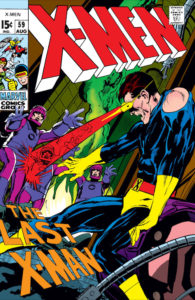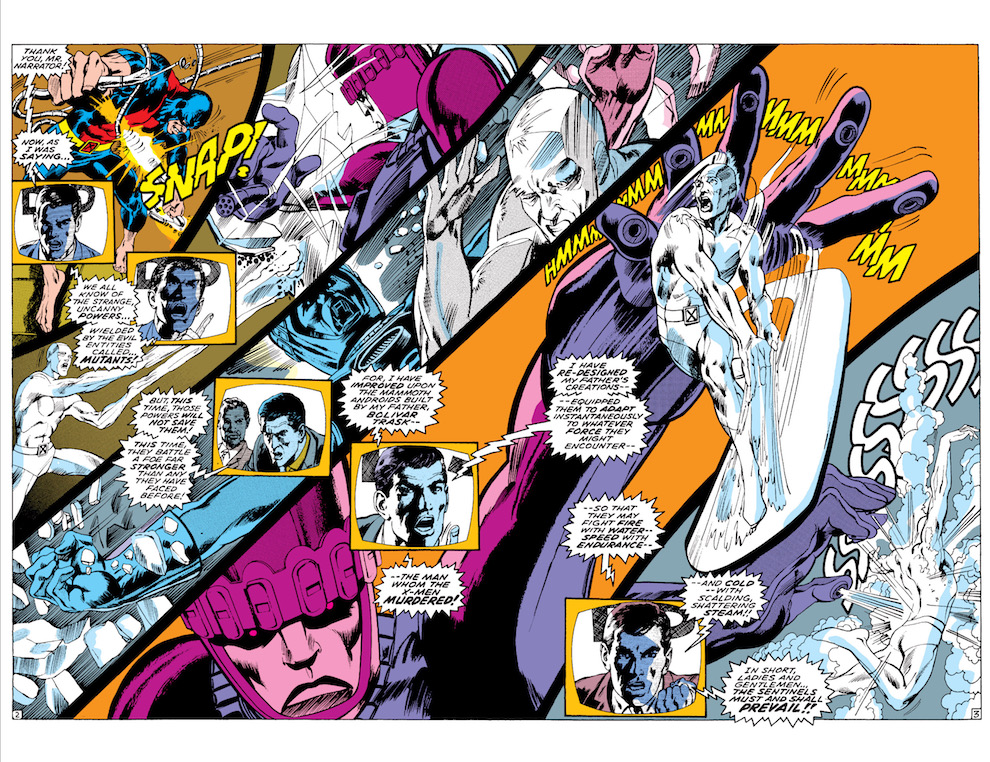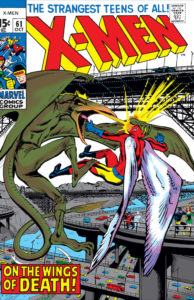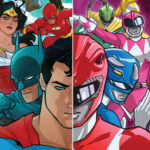
“Time has stopped before us
The sky cannot ignore us
No one can separate us
For we are all that is left
The echo bounces off me
The shadow lost beside me
There’s no more need to pretend
Cause now I can begin again”
(“The beginning is the end is the beginning”, Smashing Pumpkins)
Did we miss something?

The last time we saw the X-Men, they were fighting against the Mimic and jointly defeated him. But a lot seems to have happened while we jumped forward to the 55th issue. Scott hunts down a Pharaoh, who has kidnapped his brother Alex Summers. Also, the X-Men have a new member: Lorna Dane. She has magnetic powers and is the girlfriend of Bobby? At some point in the future, we might have to go back and read the other issues as well. But I didn’t tell you the most shocking part yet.
Are sitting down? Good. Because apparently, the Professor died. We don’t know how or why or what exactly happened during the first couple of issues of this storyline, but it must have occurred just recently.
Last but not least, the first issue of the so-called “Roy Thomas and Neal Adams run” – as the reading-order-guide I use calls this couple of issues – Neal Adams is not the artist, but Werner Roth. Adams starts to draw the comic beginning with #56.
Those seem to be the most critical three details we have to consider when getting into the next storylines. However, they are just the tip of the iceberg. There are a lot more confusing, questionable and intriguing story elements to discuss. Let’s decipher as much as we can:
Storytelling and artwork
A lot of repercussions of previous storylines can be found throughout these issues. Don’t get me wrong, there are new elements and villains as well, lot’s of them, but it is refreshing to see some consequences. The original issues were mostly single-story-issues (with a few exceptions) and didn’t have any lasting effects. But now we are not just introduced to Trask junior (his father was responsible for the Sentinel Program), we also meet Ka-Zar again.
Regarding world building, we can see some improvement as well. In issue #58, for example, we get a little scene of Magneto and his new comrade Mesmero. This couple of panels gives us the impression of a bigger, rich universe because we can see, that time is moving forward with other characters as well. We do not just look at their actions and preparations in retrospect, but as they happen. That is what you call “set up.” Still, it is not just things like that, which enriches the story. Sometimes we get information from a television newscast, and it just feels naturally implemented into the narrative.
The panel structure is different as well – compared to the original run. There are panels within panels, and the 2×3 structure from before is more or less not existent anymore. They vary in size and shape, which makes for a dynamic read, especially during the fight scenes. These changes were long overdue and can be seen in perfection when Scott takes on the main villain in issue #55.

One thing I love about modern-day comic books are two-page spreads. These are drawings of a single panel or a cumulation of panels throughout two pages. Though I read my comics on an iPad Pro, these artworks get me excited every time – if done right. Recently I read a lot of DC Comics comics. The two-page spreads of Green Arrew, Green Lanter or Titans work perfectly and enrich the story. The same is true for some of the issues of this X-Men run. They present us the first two-page spread of the series (as far as I can tell – maybe there were some in the previous issues) and it’s gorgeous. Neal Adams is a great artist. He can do anything. Be it action scenes with pages filled with fights or emotional discussions between Trask’s son and a judge – everything is engaging and beautiful to look at.
Before I talk about more specific things I like or disliked, I wanted to mention the finale. In issue #65, we can see that Roy Thomas has prepared this story for a while now. On the other hand, it is a shame to see it fulfilled in just one issue. But as the X-Men complete their first run, it doesn’t seem logical to start another epic story arc. These are the last issues of the X-Men. At least for a while. After #66 Marvel just published reprints of older stories and you might have guessed it already – they came back five years later with Giant-Sized X-Men #1.
For the final story, the Professor comes back! Yeah??! Did anyone believe, that Xavier was dead? Well, I wasn’t exactly sure, to be honest, but now we have the proof that he faked his death to prepare a strategy for the invasion of the Z’Nox. Alien invaders, with a Deathstar-like ship. Sounds awesome right? Unfortunately, as I said, it is all finished in one issue. It feels rushed. And in addition to that, we have to deal with some weird psychic reboot machine so that the Professor can function normally again. A crazy way to end things.
Be that as it may, issue #66 feels like the old issues again. Back to the basics. They even have a short training session. We’ve come full circle.
The Good, The Bad and The Ugly
Do you know what backstories are? They are additional pages at the end of a comic (not more than two or three), which tell another story of the characters within the book. One example (I am not sure if it is a good one, to be honest) is All-Star Batman by Scott Snyder. I was astonished to see something like this in an X-Men comic. As I read further into this, I discovered the following table in the dissertation Reading The Uncanny X-Men by Joseph Darowski:

As you can see they were part of the comic since issue 38 and I am quite interested in reading the other stories as well; mainly because the ones we get to see in #55 through #57 are very mixed regarding their quality. However, it is nice to see the stories have evolved and moved forward since Stan Lee. They refer to old events, the storylines go across multiple issues, and they just try new things. Backup stories are only one part of the process, and Roy Thomas was an excellent choice for Lee’s successor.
So, what were the backup stories about? The first one tells the origin of Angel aka Warren Worthington or, as he calls himself before joining the X-Men: The Avenging Angel! He stops burglars and thieves on his own. Soon the X-Men take notice of him and appear in his apartment. Another excellent example of How to NOT win someone for your cause (but we discussed this topic already in the second article of this series). Believe it or not, this is not the worst part of the story yet. No, there are short conspicuous fights between Warren and the X-Men, even a nuclear bomb is part of it all. It’s ridiculous, but a fun read, I guess.
The embarrassing part starts when Jean gets her backup story. You know, to show some respect for the character, develop a good story with depth and overcome the past. Just kidding. She gets one backup story (as in it’s done in one issue) – and the last one for crying out loud (!) – and the first things she gets to do are cleaning her apartment and baking an apple pie with the aid of her powers. Yeah! Woohoo! Feminism! That’s how you introduce an X-Woman.
I am obviously sarcastic. To be honest, it is just stupid, and the weirdest thing is, that the story was written by a woman. My expectations were high, as I saw a female writer (Linda Fite) on the list. Write a badass story. Let her do something. But what we get is not even a real story. It’s like an entry in a diary and Jean is reading it to the audience. There is no theme or plot. I cannot wait to read Chris Claremont, so let’s continue to some good stuff.
Friends and Foes (continued)

The main stories, however, which span over the course of multiple issues are excellent. The first arc with Scott’s brother and the pharaoh turns out to be a vast, rich story and I am sure if I read it again I would find more symbolism and meaning within it. You can see and feel, that the storytelling changed massively between the last issues of Stan Lee’s run and the one we discuss now. It is one long tale about the sentinels, Scotts Brother, Bobby’s girlfriend, a derailed son, a Yin-Yang-Symbolism between the Pharaoh and Alex and so much more. Roy Thomas doesn’t rush through the plot points. Instead, he gives it space to breathe. This way the reader can process and appreciate every sequence.
Most issues prominently feature Alex, and in the end, it turns out, that this is the origin story of Havok. I didn’t see that coming and was pleasantly surprised. There should be a lot more such origin stories.
One of the coolest, weirdest and funniest moments was during the final battle between the Sentinels and Scott – he is one of the last X-Men standing. He makes an Asimov-ish move and defeats these horrific machines with logic. After that, they fly into the sun and destroy themselves. I am not sure I understood how he did it, but I was reminded of the first couple of short stories by Isaac Asimov in the collection _I, Robot_ (which everyone should read).
For the next villain, I want to talk about; you need to know something: Lord of the Rings and the whole mythology of J.R.R. Tolkiens Middle-earth is an integral part of me. Unfortunately, I have to admit that I am just beginning to dive deeper into this world by reading The History of Middle-Earth books, The Silmarillion and so on and so forth. However, I watch the Lord of the Rings movies by Peter Jackson on a regular basis (which means once a year) and every time I cry and have a deep emotional experience. Don’t get me started on The Hobbit movies – I just talking about Lord of the Rings. They are treasures. I love them.
That said, we can now talk about Dr. Klaus Lykos – he plays a crucial role in the issues #60 through #62. He is a mutant and can drain the life energy of other living things, even animals. As The X-Men deliver Scott’s brother to him – Lykos is supposed to be a friend of Xavier – he finally gets enough energy to transform himself into a Pteranodon. Years ago the same creatures attacked him and gave him his power in the first place. So far so good. But, of course, he is a fan of Lord of the Rings and calls himself Sauron.
Sigh.
Why?! Just … why? You don’t do things like that. Never, ever, name anyone after one of the greatest villains of all time. Never. If Lykos would have been a big wicked evil genius with a plan and abilities to defeat the X-Men – maybe then. But the way the story is executed, I don’t buy it for a second. Sauron is like a second personality within him. He has more resemblance with Dr. Jekill and Mr. Hyde, than with anyone of Lord of the Rings. Furthermore, the X-Men don’t have to act. They are like an audience, watching the separate elements unfolding. In the end, it is all about love and forgiveness. Horrible.
OK. Now I feel better.
The coming of Sunfire
…is also the title of the 64th issue. It is a tragic story of a young boy, manipulated by an old man to fight a war, that has ended a long time ago. This story takes on a complex topic. It deals with the aftermath of Hiroshima and Nagasaki. Mind that the comic was released in the 1970s.
The boy’s name is Shiro. His mother was a victim of Hiroshima, and as a result of the nuclear fallout, Shiro got his powers. Within his body, he can contain the power of the sun itself and release it in powerful blasts. Unknown to his father, his uncle told him, since Shiro was a baby, about Hiroshima and what happened to his mother. How he hated the United States for it and that he wants revenge. It should be their right and duty to avenge those who died and those who still suffer. Therefore, when Shiro’s powers manifest, his uncle commands him to attack Washington D.C. and destroy it.
Shiro, believing in the course laid out by his uncle is ready for everything. But in Washington, a terrible accident happens, and his uncle kills Shiro’s father. When he learned of the doings of Shiro, his father sacrifices himself to save the people of the city and convince Shiro, that what he does is wrong.
As you may have noticed, this story doesn’t indeed feature the X-Men. In this case, it’s a good thing. The coming of Sunfire is an intimate, one-issue story which deals with a topic you might not expect. It’s just about Shiro and the pain of his past. It is about a young man easily manipulated by someone he should be able to trust. On the other hand: can you blame the uncle for his hatred? Then there is the father, Standing in between them. A touching story, which is now as important and relevant as it was then.
Conclusion
Roy Thomas and Neal Adams didn’t just create a couple of X-Men stories, but an entire roller coaster of emotions. I may have praised the developments that occurred between issue #19 and #55 a bit too much. However, I wanted to point out just how much has changed in the few years in between. It is great to witness the evolution of storytelling within the medium, and I think the X-Men are the perfect example of it.
In the next article we will talk about the question “What is a mutant?” and after that, we take a look at a newer interpretation of the X-Men’s origin. A series written by Jeff Parker. We are going to talk about X-Men First Class v1 (2007).
Sources
- Darowski, J. (2011). Reading The Uncanny X-Men: Gender, Race and the mutant metaphor in a popular narrative (Doctoral dissertation). Retrieved from https://etd.lib.msu.edu/islandora/object/etd:1030

![[REVIEW] HE-MAN AND THE MASTERS OF THE MULTIVERSE #1](https://geekd-out.com/wp-content/uploads/2019/11/DC33C3C1-FDFD-4373-8990-D0B3488F97C8-150x150.jpeg)

